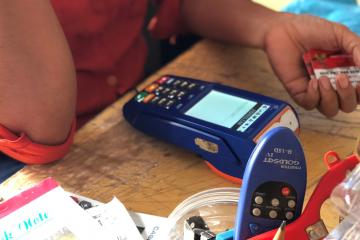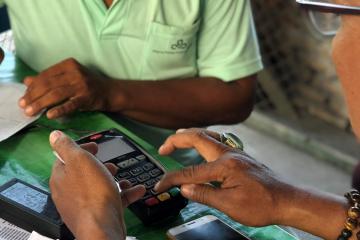
Key issues and challenges for advancing inclusive digital financial services in Indonesia
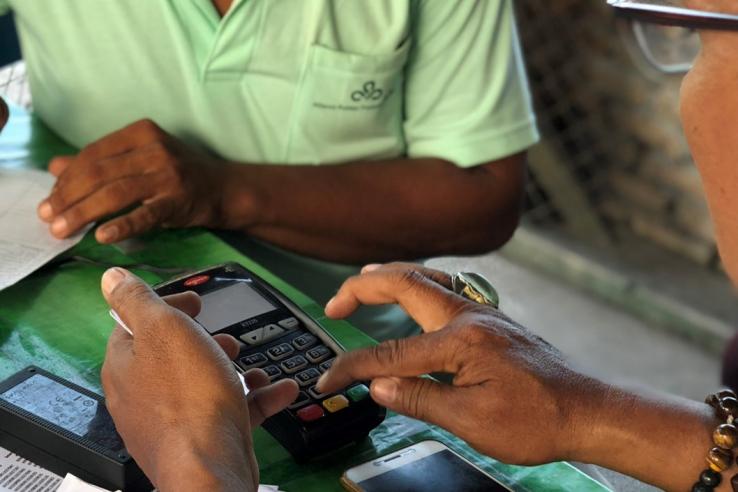
Indonesia has made significant strides in expanding financial inclusion in the recent years due to public and private sector commitment to advancing financial inclusion and the rapid emergence of various technological innovations in the digital financial services (DFS) sector. Expanding DFS innovations to lower-income and rural populations could meaningfully contribute to economic inclusion and poverty alleviation.
However, in Indonesia, most DFS innovation still favors urban and higher-income populations. An important policy question arises: how can technological innovation in finance genuinely help accelerate progress?
As part of the effort to support the Government of Indonesia’s financial inclusion agenda, J-PAL Southeast Asia (SEA) launched the Inclusive Financial Innovation Initiative (IFII). IFII was introduced in October through a webinar, “Towards Inclusive Digital Finance in Indonesia.” The event featured a presentation by Simone Schaner (USC; Co-Chair, J-PAL’s IFII) summarizing findings from the initiative’s landscape white paper and a panel discussion with Indonesian DFS policymakers Ida Rumondang (Senior Executive Researcher, Department of Financial Services Research, Indonesia’s Financial Services Authority (OJK)), and Ricky Satria (Deputy Director of Payment System Policy, Central Bank of Indonesia (BI)), and moderated by Arya Gaduh (University of Arkansas, J-PAL affiliate).
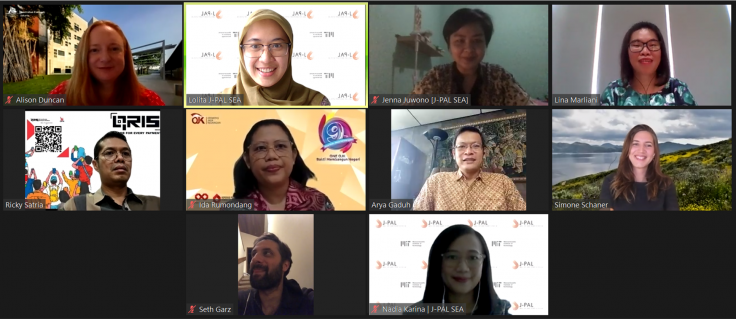
Opportunities for DFS development in Indonesia
During the launch event, Simone shared results from the IFII white paper, which provides an overview of the financial inclusion and digital finance services sector in Indonesia. Drawing from global literature review of relevant evidence, data analysis, and in-depth stakeholder interviews, this paper aims to give a high-level analysis on how DFS can be leveraged to advance inclusive economic growth and outline strategic areas for future research that can fill evidence gaps to support DFS sector development.
In addition to the presentation, there were two breakout discussion sessions where participants were met in small groups to brainstorm promising use-cases to explore as well as potential solutions to help increase awareness of social protection bank account ownership. Here are some of the highlights of the presentation and discussion:
In Indonesia, demographics are not destiny when it comes to account ownership
To help identify the barriers and triggers of financial inclusion, the IFII team analyzed the 2018 Financial Inclusion Insights (FII) survey data to predict the characteristics that lead to account ownership in Indonesia. While this analysis cannot verify what characteristics cause financial inclusion, it helps us generate hypotheses about what factors might be important.
Perhaps surprisingly, the analysis finds that demographic characteristics such as gender, education, income, and other socioeconomic factors are not the main predictors of why people own bank accounts. Rather, characteristics like participation in government’s social protection schemes and ownership of national identity as well as digital engagement (i.e. measures of phone ownership and use) are better predictors. This suggests there is scope for accelerating financial inclusion by connecting people to government systems while building their digital capabilities.
In Indonesia, digital readiness outpaces digital financial services
The FII data shows that there are far more Indonesians who have the basic skills to adopt e-money than those who are using the service. Among non-e-money users who are smartphone owners, 49 percent are able to search the internet and 45 percent have the ability to download an application. These are substantially higher than the rate of e-money use at the time of survey, which was 9.5 percent of smartphone owners.
This presents a significant opportunity for e-money providers to convert more users. This will rely on providers’ ability to ease the onboarding process and develop use-cases that appeal to the needs of users from different socioeconomic backgrounds.
Remittances, digital G2P programs, and e-commerce are promising DFS use-cases
Increasing DFS adoption, especially among lower-income and rural individuals, is challenging. During the breakout discussions, participants identified agent banking networks, digital Government-to-People (G2P) transfer disbursement, and digital People-to-People (P2P) remittances as a few examples of financial services that may help increase low-income and rural individuals’ adoption of DFS. Participants noted several other possible avenues for greater DFS inclusion:
- Participation in the government's social assistance scheme is one of the main predictors for account ownership. However, only 60 percent of beneficiaries are aware that they own a bank account. In the breakout session, the participants highlighted the lack of awareness of the basic financial features of Kartu Keluarga Sejahtera or KKS card (a bank account linked social protection card in Indonesia) as the main reason why beneficiaries don’t utilize their card for financial transactions. They suggested that cooperation between both central and local social protection stakeholders in ensuring the dissemination of the cards’ features and functions is vital. Our analysis suggests encouraging the use of social protection program-linked bank accounts amongst beneficiaries can increase financial inclusion.
- Remittances are very common amongst Indonesians. SOFIA 2017 data reports that over 60 percent of people sent and received money domestically and internationally in the past year. However, cash is currently still the predominant method to remit, suggesting there is a sizable opportunity for financial providers to develop remittance services that can make transfers easier and more convenient.
- Helping micro and small enterprises onboard and succeed in e-commerce platforms has the potential to help them increase their income and deepen their access to financial services.
In addition, participants suggested enabling e-money for bill payments and customized savings products as other promising use-cases. They also considered that successes rely on providers’ ability to provide human contact where it is most necessary to help onboard people to the financial service. One of the most important financial services touchpoints for people in rural areas is agent banking networks, where banks recruit agents to provide financial services to the community, providing greater access for those who are unable to reach a branch office or ATM. Moreover, as digital financial literacy is relatively lower among these demographics, developing easy to understand onboarding and user interfaces becomes imperative.
Key evidence gaps for developing DFS in Indonesia
There is currently relatively little rigorous evidence to inform financial inclusion policymaking. The white paper points to several strategic areas of future research that can help unearth why some DFS services/products work and why and how to scale effective DFS programs. Key focuses include designing strategies to onboard and retain new DFS users (particularly in light of COVID-19 induced transitions to DFS); designing use-cases around remittances, G2P transfers, and e-commerce; and strengthening DFS infrastructure such as agent networks.
Policymakers’ perspective on DFS in Indonesia
The event also featured representatives from Indonesia’s Financial Services Authority (OJK) and the Bank of Indonesia, who shared their reflections on the Initiative’s white paper.
Ida Rumondang (Senior Executive Researcher, OJK) highlighted the importance of continuous and multi-stakeholder efforts to promoting financial and digital literacy. In addition to the training and socialization programs developed by OJK, she emphasized the role that financial services providers and agents on the ground should play in training and consumer education. For example, to promote bank account usage among social protection beneficiaries, OJK worked alongside financial services providers, the Ministry of Social Affairs, and the Bank of Indonesia to disseminate information on bank account features and its relevance to daily life.
Ricky Satria (Deputy Director of Payment System Policy, Bank of Indonesia) highlighted the importance of interoperable and low-cost digital payment infrastructure as a way to ensure that adoption is inclusive. This is among the reasons why the Bank of Indonesia developed the standardized Quick Response Indonesia Standard (QRIS) code for e-money providers to issue for their merchants—often small to medium enterprises. However, he noted that alongside infrastructure, a campaign strategy targeting more of these businesses is equally important to drive adoption and expansion of the QRIS.
Finally, both speakers agreed that the high cost of agent management and minimal incentives for both financial services providers to provide optimal support to their agents as well as for agents to actively seek consumers, remain the two main challenges that policymakers and the private sector face in promoting financial inclusion. Improvement in agent banking network business models, features, management, and promotion could be an important step to achieving financial inclusion.
This article summarizes events from the IFII launch webinar, “Towards Inclusive Digital Finance in Indonesia,” on October 16, 2020. To read the content of the presentation, see “Towards Inclusive Digital Finance in Indonesia” by Simone Schaner (USC; Co-Chair, J-PAL’s IFII). Read the full white paper here.
Related Content

Tantangan dan Isu Utama dalam Meningkatkan Inklusi Layanan Keuangan Digital di Indonesia: Analisis Laporan White paper IFII J-PAL SEA
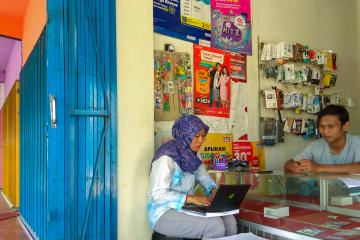
How digital financial services and e-commerce can help curb the impact of COVID-19 on people's livelihoods
